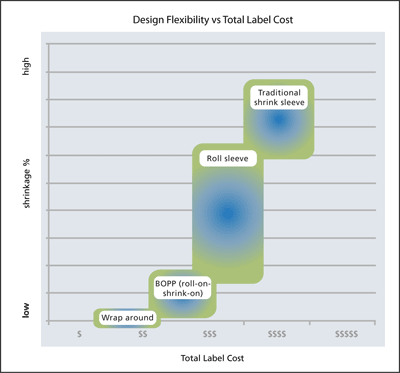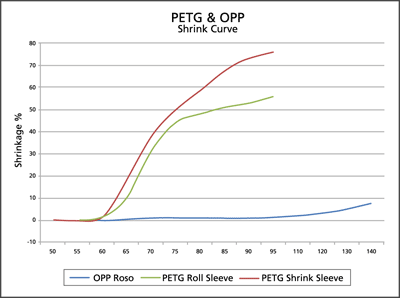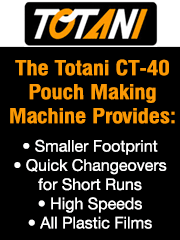Roll-Sleeve Film: Helping Shape Brand Identity
- Published: May 11, 2011, By By Kloeckner Pentaplast (www.kpfilms.com)
In today’s world of multimedia advertising and information overload, brand owners are faced with the challenge of effectively communicating with consumers and driving product trial and usage. Of all the marketing tools (advertising, coupons, etc.) at one’s disposal, there is mounting evidence that merchandising through packaging and point-of-purchase displays is the most effective in winning the proverbial “first-moment of truth.” Packaging is becoming an increasingly important part of the marketing mix, evolving from the old perfunctory role as a protector and transporter of product to being a brand ambassador and sales person to the consumer.
Consumer research by Market Focus (2009) revealed that 38% of respondents tried a product because “something caught my eye at the store” while only 8% of respondents tried a new product because of an ad they saw on TV, radio, print media, or online source. The research also indicated that 70% of brand decisions are made in-store (not what product to buy but which brand to buy), and so brands can leverage attractive packaging to draw consumer attention and break through the shelf clutter.
It is widely believed that the shopper’s eye first notices color, then shape, numbers, and finally, words. New consumer research, commissioned by Eastman Chemical through Nielsen Co., demonstrates for the first time with conclusive statistically significant data that products decorated with shrink labels “catch consumers’ attention” and are more “appealing” than products with plain labels.
Shrink-sleeve labels are a growing market trend among brand owners seeking to differentiate their products on crowded shelves and thus influence consumers’ purchasing decisions. The unique packaging design afforded by shrink sleeve’s 360-degree billboard display has become a major vehicle for creating brand differentiation and identity. The high printability of shrink-sleeve film allows for decoration and graphic impact that enhance package visibility with the ultimate goal of raising unit sales figures.
Toward such efforts, brand owners are also making increased use of shaped contours in product containers to draw consumer attention. Here, too, shrink sleeve’s conformability allows for combining interesting contours with expanded label graphics and helps account for the growing market trend in its use.
Shrink-Sleeve Quality with Existing Assets
Even more brand owners would take advantage of shrink sleeve’s attributes, but they are committed to existing equipment already installed at their facilities. Now the packaging film industry has recognized this issue and developed polyethylene terephthalate glycol (PETG) roll sleeve. These new PETG roll-fed shrink films offer brand owners the ability to accomplish several key improvements to the appearance and shape of label design with modest capital expenditure. These improvements include:
*Expand overall label size, resulting in higher brand recognition within the limitations of shelf space per package. This coincides with the ability to include more product information and advertising message per package.
*Enhance label design with the expanded area for more graphics. As with shrink sleeve, PETG roll sleeve also provides a 360-deg billboard display for increased visibility that’s optimal for creating brand recognition.
*Allow for decoration of contoured product containers given the elevated shrink-level performance of new roll-sleeve films. A higher degree of container design freedom now is possible with the ability to variously shape and contour while delivering label conformability: One of the strongest benefits of new PETG roll-fed shrink films.
*Use of a brand owner’s existing roll-fed equipment assets with minimal additional financial outlay, or else enabling the opportunity to purchase new high-speed machinery just coming onto the market.
For some time, shrink-sleeve labels have been the best choice to offer these advantages from a design and seam-quality position. However, it has required different capital equipment…until now. With PETG roll-sleeve labels, adding a shrink tunnel and making some changes in labeling units may be all that’s required to run it on roll-fed equipment. Existing roll-on shrink-on equipment also can be modified to run PETG roll sleeve. That raises the question, “Why would brand owners using roll-on shrink-on equipment even be interested in such modifications?”
Freedom & Conformability Go Hand in Hand
Traditional film materials such as bi-axially oriented polypropylene (BOPP) shrink to 10%-20% maximum. This allows only limited conformability potential for label contouring. New label materials offer shrinkages greater than 20%. This greater conformability quotient thus frees design development of containers to be shaped and contoured for enhanced shelf presence.
For some brand owners, this means that with only a retrofit to existing equipment, they can achieve nearly shrink-sleeve quality labels with all the advantages of enlarged label span and heightened graphics and advertising, along with more eye-catching contours. The end results are improved brand recognition and purchasing appeal.
For those who’ve invested considerable funds in roll-fed equipment, this is an exciting development—especially considering the seconds in which a brand has to capture consumers’ attention at the purchase point. PETG roll sleeve is well suited to brand owners that have value-added portfolios and marketing strategies in which point-of-purchase or retail-shelf impact is important to sales. They can make profitable use of this new product. PETG roll sleeve offers a chance to change the game, moving a package with little differentiation up the field to one with a higher profile.
Containers that lend themselves to PETG roll-sleeve labels can be plastic, metal, or glass. It’s ideal for PET bottles of water, functional water, carbonated soft drinks, and ready-to-drink teas and juices, as well as for PET containers of food and condiments. Also their comparatively low shrink initiation makes these labels well suited for temperature-sensitive applications such as dairy. Not only contoured bottles, but metal cans are also candidates for PETG roll-fed sleeve applications.
The latter—metal cans—highlights additional monetary advantages of PETG roll sleeve with regard to inventory reduction. The metal can shares its standard design shape with multiple-printed subcategories. Roll sleeve allows brand owners to easily make line changes on can labels as old information becomes irrelevant. Instead of having an inventory surplus of obsolete pre-labeled cans, blank cans may be used to match demand by line item, keeping overall inventory costs low.
New Welding Technologies “Seam” to be Changing
A question emerges from this discussion of PETG roll sleeve’s advantages, “Why hasn’t it been offered on the market before now?” One major obstacle has been in the area of seaming for roll-applied shrink film. Now, however, this reality has improved with welded seam solutions that work well with good results. These solutions produce seams with a clean-looking appearance.
PETG and vinyl high-shrink films, including PETG roll sleeve, weld with no gaps, creases, haze, or distortion at the seam. The finished seams are strong and hold their bond in steam, hot-air shrink, or infrared tunnels. What’s more, solvents used for this welding process are non-flammable with low VOC (volatile organic compounds) emissions. Flexcraft Industries Inc., Newark, NJ, is a leader in the development of these adhesive and coating services.
Traditionally, hot-melts have been the widely accepted option for roll-on shrink-on and roll-fed seams, but have not been commercially available for high shrink-sleeve films. Today, there is much promising work in hot-melt technology. Henkel soon will be launching a hot-melt adhesive that will work with shrink films of up to 20% shrinkage. They will be continuing to develop adhesives that can handle even greater shrinkage. This is a compelling trend that once on the market may open the potential for new applications in coming years.
Continue on Page 2
A leader in these types of applications is Krones AG. The field-proven Krones Contiroll guarantees dependable labeling of contoured containers using machine-direction films. The labeling is performed on a small rotary machine where strips of hot-melt adhesive are applied to the leading edge of the label and a solvent or ultraviolet (UV)-cured adhesive is applied to the trailing edge in order to form a secure overlap that can resist the forces present during shrinking.
If solvent is used, the pump system is positioned on the machine base in close proximity to the labeling station. If UV adhesive is required, the Krones standard hot-melt system is utilized in conjunction with a special curing tunnel located at the machine discharge. As each labeled bottle is conveyed through the tunnel, the label overlap area is exposed to high intensity UV lights forming a bond that will not separate at the high temperatures present in the shrink tunnel. One machine can handle a variety of different sizes and shapes and has the flexibility to apply both roll-sleeve and roll-fed labels.
Another development in this emerging field is the state-of-the-art labeling units that utilize PETG roll sleeve and show indications of success in new seaming techniques. This new equipment is being commercialized by companies such as the SACMI Group and Sidel.
Sidel is moving beyond its initial development of ultrasonic seaming methods to promising advancements using new thermal technology. This technology uses a heat bar to create a robust seam, showing attractive, clean-looking results. The process involves transferring containers to a bottle carousel. From the carousel, containers are raised by individual sleeve drums for labeling. The labels are transferred and wrapped around each sleeve drum using a rotary system and vacuum. The vacuum holds labels in place for sealing.
Thermal heat-sealing stations are positioned inside the carousel and match up with each sleeve drum. These stations also incorporate a cooling system, the two working together to create strong, high quality seams. From there, the sleeve drums with attached containers are lowered into the pre-seamed label sleeves.
This new thermal technology differs from traditional shrink-sleeve processes in which sleeves are lowered onto the container. One major benefit, according to Sidel, is that it doesn’t require glue or solvents for seams. Yet it still offers the flexibility of using roll-fed adhesives on their equipment lines as well. These new labeling units work well on glass, plastic, and metal containers.
At SACMI, they have incorporated seaming laser technology with specialized roll-fed equipment. The process involves applying tubular sleeve labels directly from the film while still on the roll. Sleeves are created on a series of motor-driven spindles using a vacuum method. When the film comes into contact with the spindle, or cylinder, the resulting vacuum holds it to the surface for cutting and seaming. A laser then seals the seam into place, readying it for the shrink stage. All mandrels and sleeves are located on top of the bottle as SACMI indicates this offers a cleaner labeling solution. Their process requires only one laser for the entire line.
The final outcome of this new laser technology is a label with a very attractive seam process that requires no glues or solvents. Once again brand owners are able to move easily back and forth between roll-sleeve and roll-fed labels.
Both Sidel and SACMI offer excellent seaming solutions for companies with large-volume needs. These lines necessitate their own dedicated, new capital investments. However, this high-tech labeling equipment is another consideration for interested brand owners.
Stretching the Limits of Design—A Comparison
In making any purchasing decision—including possibly converting to roll sleeve using existing equipment—each brand owner will want to compare total label cost to label performance. Figure 1 offers a rough comparison of various label processes in relation to shrink performance. Positioned on the x axis is the total label cost for a brand. Positioned on the y axis is the percentage of film shrink.

Shrink percentage indicates the ability of a label to conform to the bottle’s shaped contours. The higher the shrinkage, the greater the liberty to vary bottle dimensions and contours and still have the label conform to that shape.
On the low end of total label cost, inexpensive paper and oriented polypropylene (OPP) films are brand owner options, but they are significantly limited in terms of shape design flexibility. Costlier still are BOPP roll-on shrink films that offer less-limited shape design flexibility. On the high end of total label cost are shrink-sleeve films that have the greatest shrink percentages and, thus, provide the greatest amount of shape design flexibility.
Compared to the latter, PETG roll sleeve performs on par, delivering a high level of shape design flexibility for symmetrical containers at a lower total label cost—particularly if the brand owner is able to utilize existing roll-fed equipment.
Roll Sleeve & the Shape of the Future
With a number of new such PETG roll-sleeve products finding their way to the market as demand grows, a review of shrinkage curves for it and the other options is advisable. Figure 2 shows curves for shrink-sleeve polyester, PETG roll sleeve, and BOPP films.

As noted by the graph’s curves, PETG shrink-sleeve and PETG roll-sleeve films offer high levels of shrinkage for varying container contours. BOPP has its place in the market; however, it provides limited shrinkage, which thereby restricts bottle contour design flexibility.
As more contoured containers become an integral part of brand identity and, thus loyalty, label materials that can conform to such contours continue to be developed and expanded. Filling that niche, PETG roll sleeve is gaining the awareness and interest of brand owners so that applications for these films are on the rise.
New technology and equipment are assisting to drive PETG roll sleeve’s appeal to brand owners. For the years ahead, PETG roll sleeve appears to be filling a needed place for itself in the label market.
Supplier Information
Kloeckner Pentaplast Group | www.kpfilms.com
Eastman Chemical | www.eastman.com
Flexcraft Industries Inc. | www.flexcraftind.com
Henkel | www.henkel.com
Krones AB | www.krones.com
SACMI Group | www.sacmi.com
Sidel Group | www.sidel.com













